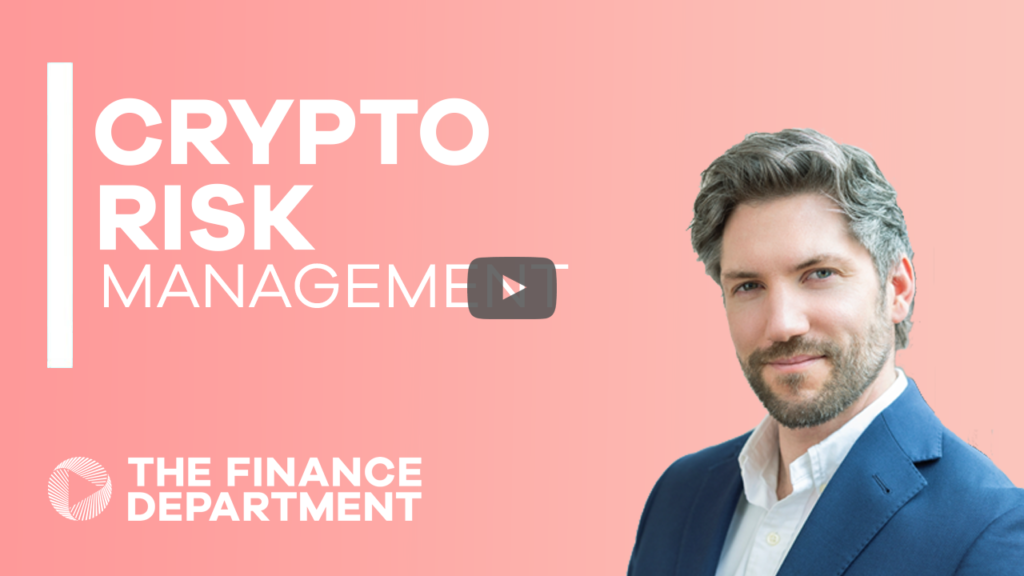How To Implement a Crypto-Specific Risk Management Framework
Join today and start learning
TFD is the learning platform built for finance professionals.
This content is available as part of our bitesized video series.
Watch this video today by joining our free community.
Join today and start learning
TFD is the learning platform built for finance professionals.
This content is available as part of our bitesized video series.
Watch this video today by joining our free community.
How To Implement a Crypto-Specific Risk Management Framework
Video information:
In this video Andrew discusses how to implement a crypto-specific risk management framework.
Risk management is an area that is currently very underutilized by large number of crypto firms that I speak to, and it really can be the differentiating factor between the longer-term winners and losers in this space.
So, if we first define what risk management is, we’ll be able to dive a little deeper into how to implement certain strategies for your company. In short, risk management is about safeguarding your company’s assets. So what does this mean in practice? Well this means, defining certain scenarios generally on the downside for your company, given certain market conditions, and setting parameters around these. Defining these adverse scenarios will then enable you to measure, monitor, and hopefully mitigate the major risks of your business.
So, these risk scenarios can be broken down even further into some more specific categories, such as market risk, credit risk and liquidity risk. There are many other risk areas, but for the purposes of this video, I’ll focus on just these three. So let’s take a look in turn.
So we all know that the world of crypto is extremely volatile. Assets in this space can rise and fall to a much greater extent than we generally see in more traditional assets. This is market risk; essentially, the risk that your assets lose value due to market moves. If for example, you have a bitcoin on your balance sheet, you’ll need to understand and be able to mitigate the impact of any large negative moves. In this example and at a minimum, you should look to understand what your company tolerances are to various prevailing bitcoin prices, and how these may impact your day-to-day business. If you find that you’re intolerances are at say a 50% drawdown, then you’d immediately need to look at your exposure to de-risk your balance sheet.
So, as with many Industries, a primary concern is, am I going to get my money back from my creditors? So crypto is absolutely no different to this and this is credit risk. You don’t want to ever be to reliant on a single counterparty to remain solvent for your business to continue. The crypto industry as a whole is growing rapidly, but there have been plenty of casualties along the way. So, you do not want to over-expose yourself to any individual counterparty. You want to keep your credit risk as low as you possibly can.
So, I’ve saved potentially the most important risk until last, and that is the risk that you run out of cash. In that said, you won’t be able to pay your contractual or your contingent liabilities. Not managing cash and your liquid assets can literally close your business down and it’s a vital part of sustaining and growing your business.You may well have considered your cash management on a day-to-day operational basis, but you should also be considering overlaying some sort of risk-based scenario to ensure that you have the right buffers in place. For example, what happens if x percent of my customers or clients default? What happens if the value of my liquid assets falls but my liabilities remain the same? Are my assets really liquid in a time of crisis? Considering these items and creating a risk framework will ensure your greatest chance of success.
So, once these risk measures have been defined, they should be measured and mitigated using a set of risk limits and indicators. For example, you may want to set a limit around your counterparty concentration. This will ensure you’re not too overexposed to any single counterparty. Another would be to set a limit or an indicator around a minimum amount of cash that you like to hold at a bank at any given time. So, risk indicators and limits should be set right at the top level of the company and they should be actively managed.
They should be reported to the relevant people on a timely basis, so that actions can be taken to resolve any issues.
Creating these risk management frameworks will set you up to be able to absorb any downturns that may come your way and will set you apart from your peers. Thank you.
A commercially minded Chief Financial Officer in the cryptocurrency and blockchain industry. I am a senior finance executive with a wealth of international banking, finance and risk management experience within bulge bracket institutions.
I am a natural communicator, a strategic thinker, and collaborative senior leader; accustomed to a fast-paced and challenging environment with a history of success.
Video information:
In this video Andrew discusses how to implement a crypto-specific risk management framework.
Risk management is an area that is currently very underutilized by large number of crypto firms that I speak to, and it really can be the differentiating factor between the longer-term winners and losers in this space.
So, if we first define what risk management is, we’ll be able to dive a little deeper into how to implement certain strategies for your company. In short, risk management is about safeguarding your company’s assets. So what does this mean in practice? Well this means, defining certain scenarios generally on the downside for your company, given certain market conditions, and setting parameters around these. Defining these adverse scenarios will then enable you to measure, monitor, and hopefully mitigate the major risks of your business.
So, these risk scenarios can be broken down even further into some more specific categories, such as market risk, credit risk and liquidity risk. There are many other risk areas, but for the purposes of this video, I’ll focus on just these three. So let’s take a look in turn.
So we all know that the world of crypto is extremely volatile. Assets in this space can rise and fall to a much greater extent than we generally see in more traditional assets. This is market risk; essentially, the risk that your assets lose value due to market moves. If for example, you have a bitcoin on your balance sheet, you’ll need to understand and be able to mitigate the impact of any large negative moves. In this example and at a minimum, you should look to understand what your company tolerances are to various prevailing bitcoin prices, and how these may impact your day-to-day business. If you find that you’re intolerances are at say a 50% drawdown, then you’d immediately need to look at your exposure to de-risk your balance sheet.
So, as with many Industries, a primary concern is, am I going to get my money back from my creditors? So crypto is absolutely no different to this and this is credit risk. You don’t want to ever be to reliant on a single counterparty to remain solvent for your business to continue. The crypto industry as a whole is growing rapidly, but there have been plenty of casualties along the way. So, you do not want to over-expose yourself to any individual counterparty. You want to keep your credit risk as low as you possibly can.
So, I’ve saved potentially the most important risk until last, and that is the risk that you run out of cash. In that said, you won’t be able to pay your contractual or your contingent liabilities. Not managing cash and your liquid assets can literally close your business down and it’s a vital part of sustaining and growing your business.You may well have considered your cash management on a day-to-day operational basis, but you should also be considering overlaying some sort of risk-based scenario to ensure that you have the right buffers in place. For example, what happens if x percent of my customers or clients default? What happens if the value of my liquid assets falls but my liabilities remain the same? Are my assets really liquid in a time of crisis? Considering these items and creating a risk framework will ensure your greatest chance of success.
So, once these risk measures have been defined, they should be measured and mitigated using a set of risk limits and indicators. For example, you may want to set a limit around your counterparty concentration. This will ensure you’re not too overexposed to any single counterparty. Another would be to set a limit or an indicator around a minimum amount of cash that you like to hold at a bank at any given time. So, risk indicators and limits should be set right at the top level of the company and they should be actively managed.
They should be reported to the relevant people on a timely basis, so that actions can be taken to resolve any issues.
Creating these risk management frameworks will set you up to be able to absorb any downturns that may come your way and will set you apart from your peers. Thank you.
A commercially minded Chief Financial Officer in the cryptocurrency and blockchain industry. I am a senior finance executive with a wealth of international banking, finance and risk management experience within bulge bracket institutions.
I am a natural communicator, a strategic thinker, and collaborative senior leader; accustomed to a fast-paced and challenging environment with a history of success.
Video information:
In this video Andrew discusses how to implement a crypto-specific risk management framework.
Risk management is an area that is currently very underutilized by large number of crypto firms that I speak to, and it really can be the differentiating factor between the longer-term winners and losers in this space.
So, if we first define what risk management is, we’ll be able to dive a little deeper into how to implement certain strategies for your company. In short, risk management is about safeguarding your company’s assets. So what does this mean in practice? Well this means, defining certain scenarios generally on the downside for your company, given certain market conditions, and setting parameters around these. Defining these adverse scenarios will then enable you to measure, monitor, and hopefully mitigate the major risks of your business.
So, these risk scenarios can be broken down even further into some more specific categories, such as market risk, credit risk and liquidity risk. There are many other risk areas, but for the purposes of this video, I’ll focus on just these three. So let’s take a look in turn.
So we all know that the world of crypto is extremely volatile. Assets in this space can rise and fall to a much greater extent than we generally see in more traditional assets. This is market risk; essentially, the risk that your assets lose value due to market moves. If for example, you have a bitcoin on your balance sheet, you’ll need to understand and be able to mitigate the impact of any large negative moves. In this example and at a minimum, you should look to understand what your company tolerances are to various prevailing bitcoin prices, and how these may impact your day-to-day business. If you find that you’re intolerances are at say a 50% drawdown, then you’d immediately need to look at your exposure to de-risk your balance sheet.
So, as with many Industries, a primary concern is, am I going to get my money back from my creditors? So crypto is absolutely no different to this and this is credit risk. You don’t want to ever be to reliant on a single counterparty to remain solvent for your business to continue. The crypto industry as a whole is growing rapidly, but there have been plenty of casualties along the way. So, you do not want to over-expose yourself to any individual counterparty. You want to keep your credit risk as low as you possibly can.
So, I’ve saved potentially the most important risk until last, and that is the risk that you run out of cash. In that said, you won’t be able to pay your contractual or your contingent liabilities. Not managing cash and your liquid assets can literally close your business down and it’s a vital part of sustaining and growing your business.You may well have considered your cash management on a day-to-day operational basis, but you should also be considering overlaying some sort of risk-based scenario to ensure that you have the right buffers in place. For example, what happens if x percent of my customers or clients default? What happens if the value of my liquid assets falls but my liabilities remain the same? Are my assets really liquid in a time of crisis? Considering these items and creating a risk framework will ensure your greatest chance of success.
So, once these risk measures have been defined, they should be measured and mitigated using a set of risk limits and indicators. For example, you may want to set a limit around your counterparty concentration. This will ensure you’re not too overexposed to any single counterparty. Another would be to set a limit or an indicator around a minimum amount of cash that you like to hold at a bank at any given time. So, risk indicators and limits should be set right at the top level of the company and they should be actively managed.
They should be reported to the relevant people on a timely basis, so that actions can be taken to resolve any issues.
Creating these risk management frameworks will set you up to be able to absorb any downturns that may come your way and will set you apart from your peers. Thank you.
A commercially minded Chief Financial Officer in the cryptocurrency and blockchain industry. I am a senior finance executive with a wealth of international banking, finance and risk management experience within bulge bracket institutions.
I am a natural communicator, a strategic thinker, and collaborative senior leader; accustomed to a fast-paced and challenging environment with a history of success.








